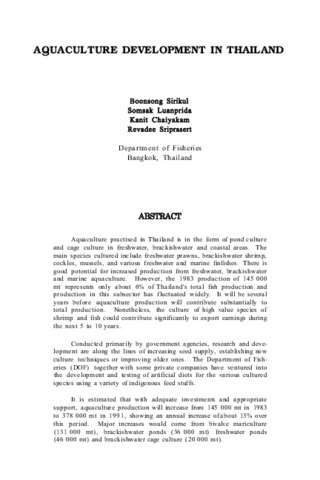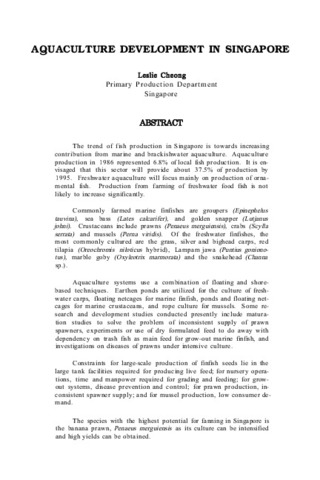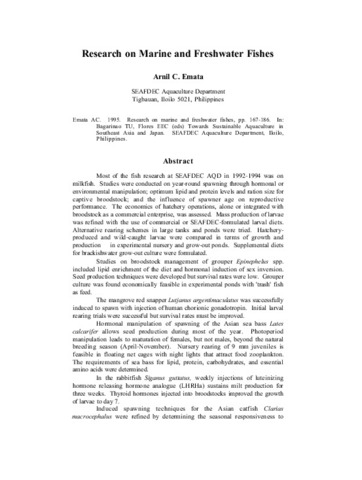| dc.contributor.author | Muhammad, Mohd Zaidi | |
| dc.contributor.editor | Villegas, Cesar T. | |
| dc.contributor.editor | Castaños, Milagros T. | |
| dc.contributor.editor | Lacierda, Rodrigo B. | |
| dc.date.accessioned | 2011-09-15T08:16:37Z | |
| dc.date.available | 2011-09-15T08:16:37Z | |
| dc.date.issued | 1993 | |
| dc.identifier.citation | Muhammad, M. Z. (1993). Seed production of marine fish in Malaysia. In C. T. Villegas, M. T. Castaños, & R. B. Lacierda (Eds.), Proceedings of the Aquaculture Workshop for SEAFDEC/AQD Training Alumni, 8-11 September 1992, Iloilo, Philippines (pp. 21-26). Tigbauan, Iloilo, Philippines: Aquaculture Department, Southeast Asian Fisheries Development Center. | en |
| dc.identifier.isbn | 9718511253 | |
| dc.identifier.uri | http://hdl.handle.net/10862/643 | |
| dc.description.abstract | Aquaculture especially brackishwater fish culture in Malaysia has a very high potential for development. It is also a very important source of protein. The three major species cultured in cages are sea bass, grouper, and snapper. They are very popular, especially sea bass which is a highly esteemed delicacy. Sea bass culture started in the mid-1970. The fry was obtained from the wild or imported from Thailand or Singapore. This industry developed slowly because of inadequate supply of seed. During this period also, the culturist had very little experience in managing the cages.
As an answer to the problems of the industry, the Fisheries Research Institute (FRI) of the Department of Fisheries, Ministry of Agriculture, Glugor, Penang, established a unit responsible for research on hatchery propagation, larval feed development, and cage culture of sea bass. The Brackishwater Unit of FRI situated in Gelang Patah, Johor is responsible for research and development of sea bass grow-out in coastal ponds. The Marine Finfish Production and Research Centre (MFPRC) situated in Tanjung Demong, Terengganu was set up in 1982 for marine fish fry mass production. The Extension Branch of the Department of Fisheries in Kuala Lumpur is responsible for all extension services, including promotion of sea bass aquaculture as well as other species. The Extension Branch also operates the MFPRC and organizes training on coastal aquaculture at the Brackishwater Aquaculture Centre in Johor.
The Fisheries Development Authority of Malaysia (LKIM), a government statutory body formed in 1971 with the objectives of upgrading the socioeconomic status of fishermen and developing the fisheries industry, is also involved in marine fish culture, especially in setting up commercial culture projects involving local fishermen.
In addition to government bodies, some universities in Malaysia also carry out activities related to marine fish culture, especially disease studies. | en |
| dc.language.iso | en | en |
| dc.publisher | Aquaculture Department, Southeast Asian Fisheries Development Center | en |
| dc.subject | Lutjanus argentimaculatus | en |
| dc.subject | Lates calcarifer | en |
| dc.subject | Epinephelus tauvina | en |
| dc.subject | Malaysia | en |
| dc.subject | Giant perch | en |
| dc.subject | Mangrove jack | en |
| dc.title | Seed production of marine fish in Malaysia | en |
| dc.type | Conference paper | en |
| dc.citation.spage | 21 | |
| dc.citation.epage | 26 | |
| dc.subject.asfa | seed (aquaculture) | en |
| dc.subject.asfa | marine fish | en |
| dc.subject.asfa | feeds | en |
| dc.subject.asfa | cage culture | en |
| dc.subject.asfa | seed production | en |
| dc.subject.asfa | cultured organisms | en |
| dc.subject.asfa | brackishwater fishes | en |
| dc.subject.asfa | fish larvae | en |
| dc.subject.asfa | fish culture | en |
| dc.citation.conferenceTitle | Proceedings of the Aquaculture Workshop for SEAFDEC/AQD Training Alumni, 8-11 September 1992, Iloilo, Philippines | en |
| dc.subject.scientificName | Lates calcarifer | en |



